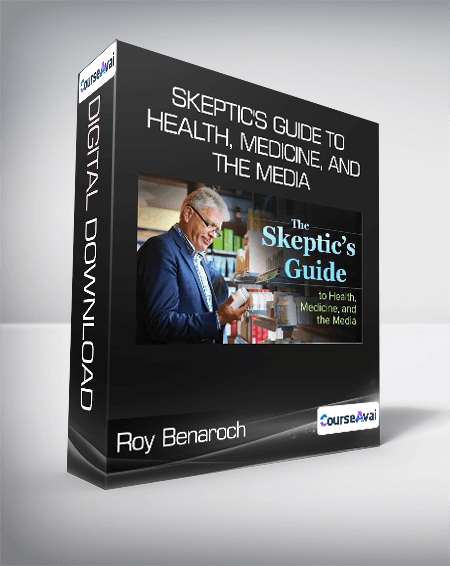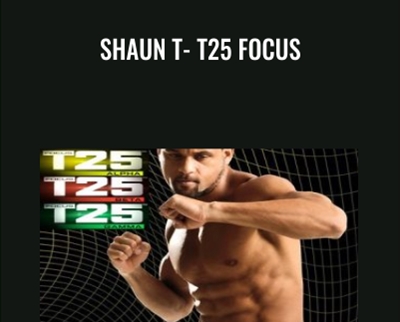Roy Benaroch – Skeptic’s Guide to Health, Medicine, and the Media
Original price was: $52.00.$14.00Current price is: $14.00.
Salepage link: At HERE. Archive:
Roy Benaroch – Skeptic’s Guide to Health, Medicine, and the Media
If you’ve ever sneezed while driving your car, did you immediately think, “Cars Cause the Common Cold!”? No, of course not. A headline like that wouldn’t make any sense. And yet, some of the sources we rely on for health and medical news are not much better. Many media outlets are perfectly happy to grab us with a wacky headline or an article that reflects none of the nuance of the study on which it’s based—as long as we buy the magazine or click through to the article. And we do. We take the bait. With 50,000 scientific studies published each week in English, many media outlets don’t put in the time and effort to adequately decipher and report on even a tiny fraction of those studies. But they publish news about them, anyway.
Hide Full Description
Get Roy Benaroch – Skeptic’s Guide to Health, Medicine, and the Media download
As consumers of medical news, how can we know whether the article we just read is based on solid science or trash?
We know we can’t believe every article we read. If we did, we’d conclude that everything causes cancer; any non-organic food will cause our death; we should never eat fats or carbohydrates; and high-dose supplements of every vitamin will save our lives or, depending on the specific article, kill us.
Professor Roy Benaroch of Emory University School of Medicine provides just the direction we need to answer important questions, look beyond media hype, and more in The Skeptic’s Guide to Health, Medicine, and the Media. In 24 fascinating lectures that address the most important health issues of our day, Dr. Benaroch shows us how to recognize the good reporting that provides balanced, accurate, and well-sourced information and the bad reporting that is incomplete at best and purposely misleading at worst. You’ll learn how to ask the questions that take you past the headlines and beyond the way health news is typically reported.
Would You Believe?
Dr. Benaroch provides numerous examples of headlines you wouldn’t fall for—or would you? While some headlines are published on obscure internet sites, others are published in some of the largest, most-trusted papers in the country. Every day, people take the bait to read about:
“Breatharian Couple Survives on the Universe’s Energy Instead of Food.” Just a little bit of digging reveals that the couple actually does eat food. Of course, they do.
“Traces of Controversial Herbicide Are Found in Ben & Jerry’s Ice Cream.” The article itself states that a typical child would need to consume 145,000 eight-ounce servings a day to reach the federal safety limit of the chemical in question. But the headline made for great “clickbait” since it used the successful technique of pairing a random fact with a recognizable brand name.
“The Soothing Benefit of Acupuncture for Babies.” The article states the goal of the study was to use acupuncture to soothe babies and shorten their crying spells—and then makes it clear that the acupuncture didn’t actually work. Yet, you would never know this from the headline.
Addressing the Top Medical Controversies of the Day
In providing samples of both good and bad medical journalism, The Skeptic’s Guide addresses both significant medical topics and smaller, everyday questions like, “Should I floss?” Some of the major issues and subjects you will look at include:
Cardiovascular health and the new blood pressure guidelines,
Cancer screenings and treatment,
The opioid crisis,
The obesity epidemic,
The price of prescription medication,
The stigma of mental health, and more.
To better understand these issues in all their complexity, you’ll go behind the headlines to learn more about the subjects themselves, as well as the media’s role in addressing them.
Building Your Skeptic’s Toolkit
With so many false or misleading sources out there, it can be natural for readers to become cynical about medical reporting and headline news. However, as Dr. Benaroch points out, there’s a difference between being a cynic and being a skeptic. Becoming a cynic and believing nothing of what you read would be just as ineffective as being gullible and believing everything. There is good health-related information out there, and The Skeptic’s Guide to Health, Medicine, and Media will teach you how to access it. You’ll learn six specific questions to ask yourself as you read, all of which begin with the letter “s” for ease of remembering. These questions form the basis of your “Skeptic’s Toolkit,” the lens through which you can determine the value of any article. They are:
Source. What’s the source of the article and is it credible for medical information? Is the article based on a study from a reputable university or research institute? Or is it based on anecdotal information from a non-scientist? You might be interested in reading a first-person account about someone whose blood pressure improved when she started drinking tea—but you wouldn’t want to base your own medical decisions on it.
Strength. Is the evidence presented strong enough to be valuable? Stories that review large clinical trials are much stronger than stories about small pilot studies. Dr. Benaroch explains why the strongest studies are the gold standard double-blind, randomized, placebo-controlled experiments with a large number of participants.
Salesmanship. Is the article trying to sell me something or promote a particular brand? Many media accounts are repackaged press releases whose purpose is to sell a product. That doesn’t mean the story is false, but it does mean you’re probably not getting a balanced viewpoint. And salesmanship works—as evidenced by, among other examples, the $1.2-billion fish oil supplement industry in the United States that is going strong despite 15 years of research that reveals no actual health benefits.
Salience. Is this study about people like me, and are the factors they’re measuring in the study important to me? If the article refers to a study about children, you can’t assume the results hold true for adults. As one example, Dr. Benaroch highlights an article claiming to show that cell phone exposure increases the risk of cancer. But actually, the experiment was conducted on rats.
Sides of the Scale. Does the news report try to present a viewpoint from scientists not directly involved in the study, or from people with appropriate expertise who can offer a balanced viewpoint? The article should quote additional experts in the field, not just the study authors. And, if there are legitimate disagreements about the study, those should be mentioned, too. But don’t fall for a false equivalence in which invalid or untrue assertions are given equal weight to established scientific consensus.
Sensible. Is the story itself sensible, making sense and fitting in with what we already know? It doesn’t matter how many times you sneeze while driving, we know that cars do not cause the common cold—no matter how nice the alliteration sounds. Exaggerations in headlines should also send up a red flag. “Miracle cures” and “magic bullet” might get our attention, but those descriptions almost always point to inflated or false claims.
With Dr. Benaroch’s guidance, you’ll know how to find information you can truly rely on. And you’ll know which articles to put straight in the trash.
Get Roy Benaroch – Skeptic’s Guide to Health, Medicine, and the Media download
Here's an overview of the prominent keywords and a list of famous authors:
Business and Sales: Explore business strategies, sales skills, entrepreneurship, and brand-building from authors like Joe Wicks, Jillian Michaels, and Tony Horton.
Sports and Fitness: Enhance athleticism, improve health and fitness with guidance from experts like Shaun T, Kayla Itsines, and Yoga with Adriene.
Personal Development: Develop communication skills, time management, creative thinking, and enhance self-awareness from authors like Gretchen Rubin, Simon Sinek, and Marie Kondo.
Technology and Coding: Learn about artificial intelligence, data analytics, programming, and blockchain technology from thought leaders like Neil deGrasse Tyson, Amy Cuddy, and Malcolm Gladwell.
Lifestyle and Wellness: Discover courses on holistic health, yoga, and healthy living from authors like Elizabeth Gilbert, Bill Nye, and Tracy Anderson.
Art and Creativity: Explore the world of art, creativity, and painting with guidance from renowned artists like Bob Ross and others.
All the courses on WSOlib are led by top authors and experts in their respective fields. Rest assured that the knowledge and skills you acquire are reliable and highly applicable.
Specification: Roy Benaroch – Skeptic’s Guide to Health, Medicine, and the Media
|
User Reviews
Only logged in customers who have purchased this product may leave a review.

Original price was: $52.00.$14.00Current price is: $14.00.













There are no reviews yet.